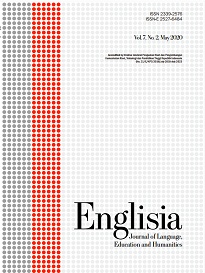Developing Speaking Skill: Barriers Faced by the Bangladeshi EFL Learners
DOI:
https://doi.org/10.22373/ej.v7i2.6257Keywords:
Speaking, EFL learners, barriers, fossilizationAbstract
This study aims at investigating the prevailing barriers for developing English speaking skill faced by the undergraduate students in Bangladesh. The attempt was to locate the importance of speaking proficiency in English as one of the basic skills of a language in this “English” era. In this global age, the use of English has been inevitable and more often we cannot but use English in different phases of our life. But Bangladeshi EFL learners often fail to attain proper speaking proficiency for some reasons. The reasons behind the incompetence in speaking skill are many and some of them are the influence of mother tongue, lack of vocabulary, lack of practice, unfavorable environment, teachers’ non-cooperation, shyness, fear, language ‘fossilization’ etc. Moreover, students do not get the opportunity to develop English speaking skill in a ‘natural’ environment. The nature of the study is quantitative and the data collection tool is a questionnaire. This paper pinpoints all those problems and presents plausible recommendations in order for developing English speaking skill.
Downloads
References
Ahmed, B. (2003). The communicative approach to English language teaching at the secondary and higher secondary level. Stamford University Journal, 125-129.
Breidenstein, A., Fahey, K., Glickman, C., & Hensley, F. (2012). Leading for powerful learning: A guide for instructional leaders. New York: Teachers College Press.
Brown, G., & Yule, G. (1983). Teaching the spoken language. Cambridge: Cambridge University Press.
Canagarajah, S. (2014). In search of a new paradigm for teaching English as an international language. TESOL Journal, 5(4), 767–785.
Cao, C., & Meng, Q. (2020). Exploring personality traits as predictors of English achievement and global competence among Chinese university students: English learning motivation as the moderator. Learning and Individual Differences, 77, 1-10.
Copland, F., Garton, S., & Burns, A. (2013). Challenges in teaching English to young learners: Global perspectives and local realities. TESOL Quarterly, 48(4), 738–762.
Creswell, J.W., & Creswell, J. D. (2018). Research design: Qualitative, quantitative, and mixed methods approaches (5th ed.). Thousand Oaks, California: Sage
Daft, L., & Samson, D. (2015). Fundamental of management. Orlando, Florida: Cengage Learning
Ellis, R. (1985). Understanding second language acquisition. Oxford: Oxford University Press.
Khan, S. R. (2003). Language learning in Bangladesh, Language policy, planning and practice: A south Asian perspective. Karachi: Oxford University Press.
Littlewood, W. (1981). Communicative language teaching: An introduction. Cambridge: Cambridge University Press.
Mackenzie, I. (2014). English as a lingua franca: Theorizing and teaching English. New York: Routledge
Moeller, A.J., & Catalano, T. (2015). Foreign language teaching and learning. In J.D. Wright (Ed.), International Encyclopedia for Social and Behavioral Sciences 2nd Edition. Oxford: Pergamon Press, 9, 327-332
Nunan, D. (2006). Practical English language teaching. New York: McGraw Hill.
Rescorla, M. (2019). The language of thought hypothesis, The Stanford Encyclopedia of Philosophy.
Richards, J. C. (1990). The language teaching matrix. Cambridge: Cambridge University Press.
Richards, J.C. (2006). Communicative language teaching today. New York: Cambridge University Press.
Richards, J.C. (2015). Error analysis: Perspectives on second language acquisition. London: Longman.
Rivers, W. M. (1981). Teaching foreign language skills. Chicago: The University of Chicago Press.
Shahidulla, M, et al. (2001). English for today for class 11-12. Dhaka: National Curriculum and Textbook Board.
Weaver, W. (1949). Recent contributions to the mathematical theory of communication. New York: The University of Chicago Press.
Widdowson, H.G. (2003). Defining issues in English language teaching. New York: Oxford University Press.
Downloads
Additional Files
Published
Issue
Section
License
Proposed Policy for Journals That Offer Open Access
Authors who publish with Englisia journal agree to the following terms:
- Authors retain copyright and grant the journal right of first publication with the work simultaneously licensed under a Creative Commons Attribution License that allows others to share the work with an acknowledgement of the work's authorship and initial publication in this journal.
- Authors are able to enter into separate, additional contractual arrangements for the non-exclusive distribution of the journal's published version of the work (e.g., post it to an institutional repository or publish it in a book), with an acknowledgement of its initial publication in this journal.
- Authors are permitted and encouraged to post their work online (e.g., in institutional repositories or on their website) prior to and during the submission process, as it can lead to productive exchanges, as well as earlier and greater citation of published work (See The Effect of Open Access).









